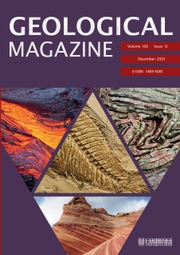No CrossRef data available.
Article contents
II.—The Lower Carboniferous Problem in Devonshire
Published online by Cambridge University Press: 01 May 2009
Extract
What represents the Carboniferous Limestone in Devonshire, is a question that has often been asked, but has never yet been answered in a satisfactory manner. The question has recently been narrowed by the identification of the Coddon Hill Beds and the Posidonomya limestones with the shales, cherts, and limestones which overlie the mass of the Carboniferous Limestone in South Wales, and with the Pendleside Beds which occupy a similar position in Staffordshire, Derbyshire, and South Yorkshire. Dr. W. Hind considers these beds to be more intimately connected with the Upper than with the Lower Carboniferous Series, and in any case the homotaxial equivalent of the main mass of the Carboniferous Limestone must be sought for below them.
- Type
- Original Articles
- Information
- Copyright
- Copyright © Cambridge University Press 1905
References
page 353 note 1 See Summary Prog. Geol. Survey for 1900, p. 87.
page 353 noet 2 By Dr. Wheelton Hind in Geol. Mag., Dec. V, Vol. I, p. 392 (1904).
page 355 note 1 Trans. Inst. Mining Eng., vol. xx, p. 9 of reprint.
page 355 note 2 The Wearde sandstones and associated volcanic rocks are now included in the Upper Devonian.
page 355 note 3 Quart. Journ. Geol. Soc., vol. xxxvi, p. 284.
page 355 note 4 Proc. Som. Arch. and Nat. Hist. Soc., vol. xlvi, p. 51 of reprint.
page 356 note 1 Summary of Prog. Geol. Survey for 1897.
page 356 note 2 Geol. Mag., Dec. II, Vol. V, p. 207.
page 357 note 1 See de Lapparent's Traité de Géologie, 4th ed., p. 895, and references.
page 357 note 2 Contrib. à l'étude micro. des terr. sédim.: Mem. Soc. Géol. Nord, tom, Lille, 1897.
page 357 note 3 Stratigraphical Geology, p. 269, Stanford (1901).


